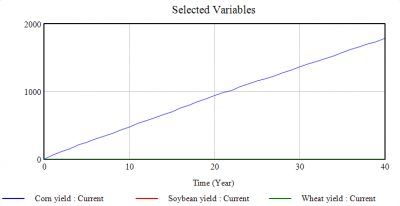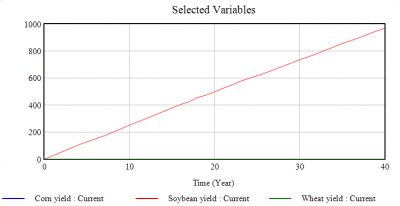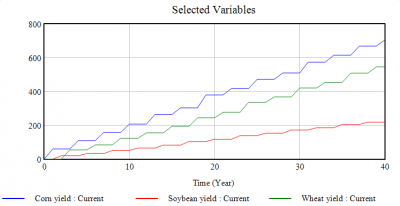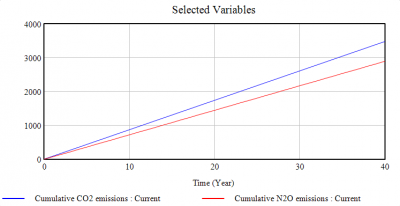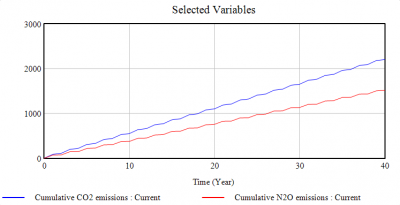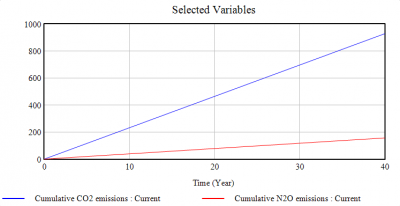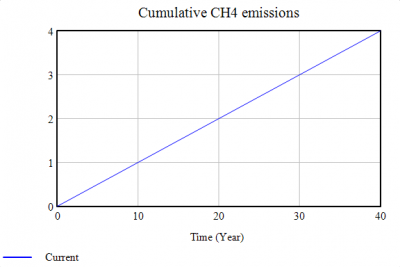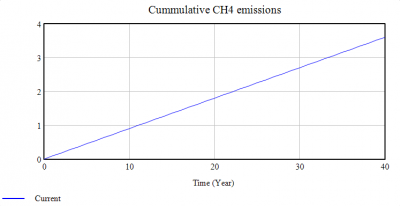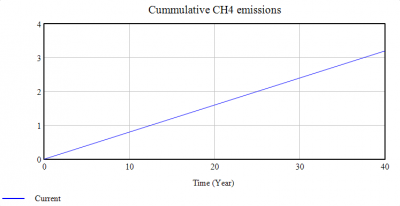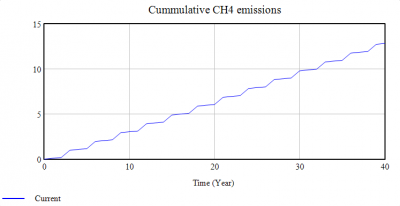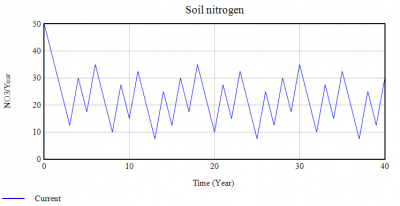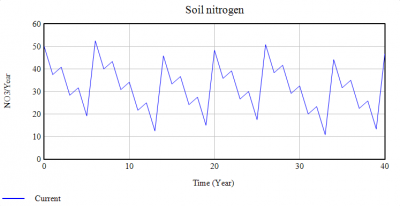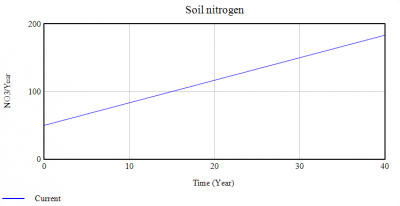Difference between revisions of "Crop Rotation in sustainable farming"
| Line 231: | Line 231: | ||
===Yields=== | ===Yields=== | ||
| − | [[File:CCC yield.png]] | + | CCC Yield |
| + | [[File:CCC yield.png|400px|CCC Yield]] | ||
| − | [[File:CS yield.png]] | + | CS Yield |
| + | [[File:CS yield.png|400px|CS Yield]] | ||
| − | [[File:SSS yield.png]] | + | SSS Yield |
| + | [[File:SSS yield.png|400px|SSS Yield]] | ||
| + | |||
| + | CSW Yield | ||
| + | [[File:CSW yield.png|400px|CSW Yield]] | ||
| − | |||
===N2O and CO2 emissions=== | ===N2O and CO2 emissions=== | ||
| − | [[File:CCC N2O CO2.png]] | + | CCC N2O CO2 |
| + | [[File:CCC N2O CO2.png|400px|CCC N2O CO2]] | ||
| − | [[File:CS N2O CO2.png]] | + | CS N2O CO2 |
| + | [[File:CS N2O CO2.png|400px|CS N2O CO2]] | ||
| − | [[File:SSS N2O CO2.png]] | + | SSS N2O CO2 |
| + | [[File:SSS N2O CO2.png|400px|SSS N2O CO2]] | ||
| − | [[File:CSW N2O CO2.png]] | + | CSW N2O CO2 |
| + | [[File:CSW N2O CO2.png|400px|CSW N2O CO2]] | ||
===CH4 emissions=== | ===CH4 emissions=== | ||
| − | [[File:CCC CH4.png]] | + | CCC CH4 |
| + | [[File:CCC CH4.png|400px|CCC CH4]] | ||
| − | [[File:CS CH4.png]] | + | CS CH4 |
| + | [[File:CS CH4.png|400px|CS CH4]] | ||
| − | [[File:SSS CH4.png]] | + | SSS CH4 |
| + | [[File:SSS CH4.png|400px|SSS CH4]] | ||
| − | [[File:CSW CH4.png]] | + | CSW CH4 |
| + | [[File:CSW CH4.png|400px|CSW CH4]] | ||
===Soil nitrogen=== | ===Soil nitrogen=== | ||
| − | [[File:CCC soil nitrogen.png]] | + | CCC soil nitrogen |
| + | [[File:CCC soil nitrogen.png|400px|CCC soil nitrogen]] | ||
| − | [[File:CS soil nitrogen.png]] | + | CS soil nitrogen |
| + | [[File:CS soil nitrogen.png|400px|CS soil nitrogen]] | ||
| − | [[File:SSS soil nitrogen.png]] | + | SSS soil nitrogen |
| + | [[File:SSS soil nitrogen.png|400px|SSS soil nitrogen]] | ||
| − | [[File:CSW soil nitrogen.png]] | + | CSW soil nitrogen |
| + | [[File:CSW soil nitrogen.png|400px|CSW soil nitrogen]] | ||
=Conclusion= | =Conclusion= | ||
=Code= | =Code= | ||
| + | |||
| + | [http://www.simulace.info/index.php/File:Crop_rotation_finished.mdl Crop rotation VENSIM model] | ||
=References= | =References= | ||
| + | |||
| + | #BEHNKE, Gevan D., Stacy M. ZUBER, Cameron M. PITTELKOW, Emerson D. NAFZIGER a María B. VILLAMIL. Long-term crop rotation and tillage effects on soil greenhouse gas emissions and crop production in Illinois, USA. Agriculture, Ecosystems & Environment [online]. 2018, 261, 62-70 [cit. 2020-01-26]. DOI: 10.1016/j.agee.2018.03.007. ISSN 01678809. Availiable: https://linkinghub.elsevier.com/retrieve/pii/S0167880918301221 | ||
| + | # | ||
| + | # | ||
Revision as of 17:39, 26 January 2020
Contents
- 1 Problem definition
- 2 Method
- 3 Model
- 3.1 Variables
- 3.1.1 Number of rotated crops
- 3.1.2 Corn production
- 3.1.3 Soybean production
- 3.1.4 Wheat production
- 3.1.5 Corn quantity
- 3.1.6 Soybean quantity
- 3.1.7 Wheat quantity
- 3.1.8 increase of N2O emissions
- 3.1.9 increase of CO2 emissions
- 3.1.10 increase of CH4 emissions
- 3.1.11 Cumulative N2O emissions
- 3.1.12 Cumulative CO2 emissions
- 3.1.13 Cumulative CH4 emissions
- 3.1.14 Corn N2O emission coef
- 3.1.15 Soybean N2O emission coef
- 3.1.16 Wheat N2O emission coef
- 3.1.17 Corn CO2 emission coef
- 3.1.18 Soybean CO2 emission coef
- 3.1.19 Wheat CO2 emission coef
- 3.1.20 Corn CH4 emission coef
- 3.1.21 Soybean CH4 emission coef
- 3.1.22 Wheat CH4 emission coef
- 3.1.23 Inorganic fertilizer
- 3.1.24 Soil nitrogen
- 3.1.25 increase of soil N
- 3.1.26 decrease of soil N
- 3.1.27 Soil nitrogen level
- 3.1.28 Temperature
- 3.1.29 Precipitation
- 3.1.30 Pests
- 3.1.31 Natural disasters
- 3.1.32 Tillage
- 3.1.33 increase of C yield
- 3.1.34 increase of S yield
- 3.1.35 increase of W yield
- 3.1.36 Corn yield
- 3.1.37 Soybean yield
- 3.1.38 Wheat yield
- 3.1.39 Total yield
- 3.1 Variables
- 4 Results
- 5 Conclusion
- 6 Code
- 7 References
Problem definition
Crop rotation is based on growing a series of different types of crops in the same area in sequential seasons. The planned rotation may vary from a growing season to a few years or even longer periods. It is one of the most effective agricultural control strategies that is used in preventing the loss of soil fertility. It also helps in reducing soil erosion and increases crop yield. Planning an effective crop rotation requires weighing fixed and fluctuating production circumstances: market, farm size, labor supply, climate, soil type, growing practices, etc.
In this simulation I will try to find parameters which have impact on the whole process of crop rotation with goal to find model providing desired outputs (these were slightly changed from concept) - crop yields, greenhouse gas emissions (N2O, CO2, NH4), soil fertility (nitrogen levels).
I will focus on four crop rotation strategies with three different crops - corn, soybean, wheat:
CCC (continuous corn) - only corn will be farmed for the whole observed time period (40 years)
CS (corn-soybean) - rotation of corn and soybean will be used in year cycles for the whole observed time period (40 years), first year corn, second year soybean, repeat..
SSS (continuous soybean) - only soybean will be farmed for the whole observed time period (40 years)
CSW (corn-soybean-wheat) - rotation of corn, soybean and wheat will be used in year cycles for the whole observed time period (40 years), first year corn, second year soybean, third year wheat, repeat..
Goal of this simulation is to observe dynamic changes with yields, greenhouse gas emissions, tillage strategy and soil nitrogen levels, while changing different crop rotation strategies.
Method
Vensim modelling approach was selected due to dynamic behavior of the simulated system.
Model
Following vensim model was developed based on the study.
Variables
Number of rotated crops
Input constant variable which can be changed based on crop strategy. Range <1,3>.
=1 (in case of CCC and SSS strategies)
=2 (in case of CS strategy)
=3 (in case of CSW strategy)
Corn production
PULSE TRAIN function ensures specific crop to be delivered by time pattern. In crop rotation strategies, if corn is present, it is always first crop, therefore it starts at time 0 (first year), duration is 1 year, repetition is based on number of crops (eg. 2 - it repeats in third year) and final time is set to fixed 40 years according to simulation setup.
=Corn quantity*PULSE TRAIN(0, 1 , Number of rotated crops ,40)
Soybean production
Similar case as in Corn production variable only with difference of initial year, if sobyean is present in crop rotation strategy, it is always second crop, therefore it starts at time 1 (second year). In case of SSS strategy it starts at time 0 (first year)
=Soybean quantity*PULSE TRAIN(IF THEN ELSE(Number of rotated crops=1, 0 , 1 ), 1 , Number of rotated crops , 40 )
Wheat production
Similar case as in Corn production variable only with difference of initial year, if wheat is present in crop rotation strategy, it is always third crop, therefore it starts at time 2 (third year).
=Wheat quantity*PULSE TRAIN(2, 1 , Number of rotated crops , 40 )
Corn quantity
Input constant variable which can be changed based on crop strategy. Range <0,100>.
=100 (in case of CCC, CS and CSW strategies)
=0 (in case of SSS strategy)
Soybean quantity
Input constant variable which can be changed based on crop strategy. Range <0,40>.
=40 (in case of CS, SSS and CSW strategies)
=0 (in case of CCC strategy)
Wheat quantity
Input constant variable which can be changed based on crop strategy. Range <0,80>.
=80 (in case of CSW strategy)
=0 (in case of CCC, CS, SSS strategies)
increase of N2O emissions
Auxiliary variable which changes based on each crop production and its emission coefficient (pattern was extracted from a study),additionaly it changes slightly according to tillage strategy and usage of extra inorganic fertilizer.
Corn production*Corn N2O emission coef*IF THEN ELSE(Tillage=0, 1.5 , 1.4)+ Soybean production*Soybean N2O emission coef*IF THEN ELSE(Tillage=0, 1.5 , 1.4)+ Wheat production*Wheat N2O emission coef*IF THEN ELSE(Tillage=0, 1.5 , 1.4)+ Inorganic fertilizer/5
increase of CO2 emissions
Similar auxiliary variable as increase of N20 emissions extra except zero effect with inorganic fertilizer.
Corn production*Corn CO2 emission coef*IF THEN ELSE(Tillage=0, 3 , 2.9)+Soybean production*Soybean CO2 emission coef*IF THEN ELSE(Tillage=0, 3 , 2.9)+Wheat production
- Wheat CO2 emission coef*IF THEN ELSE(Tillage=0, 3 , 2.9)
increase of CH4 emissions
Similar auxiliary variable as increase of N20 emissions extra except zero effect with inorganic fertilizer.
Corn production*Corn CH4 emission coef*IF THEN ELSE(Tillage=0, 0.3 , 0.2)+Soybean production*Soybean CH4 emission coef*IF THEN ELSE(Tillage=0, 0.3 , 0.2)+Wheat production
- Wheat CH4 emission coef*IF THEN ELSE(Tillage=0, 0.3 , 0.2)
Cumulative N2O emissions
=INTEG(increase of N2O emissions)
Cumulative CO2 emissions
=INTEG(increase of CO2 emissions)
Cumulative CH4 emissions
=INTEG(increase of CH4 emissions)
Corn N2O emission coef
Constant variable extracted from study and its data, representing how much N20 emissions is produced while producing corn. Can be adjusted in the future. Further coefficients are similar just crop and emission type changes.
=0.5
Soybean N2O emission coef
=0.07
Wheat N2O emission coef
=0.005
Corn CO2 emission coef
=0.3
Soybean CO2 emission coef
=0.2
Wheat CO2 emission coef
=0.25
Corn CH4 emission coef
=0.005
Soybean CH4 emission coef
=0.01
Wheat CH4 emission coef
=0.05
Inorganic fertilizer
Auxiliary variable observes if soil nitrogens decrease below 20 and applies 30 units of fertilizer (which affects NO2 emissions)
=IF THEN ELSE(Soil nitrogen<20, 30 , 0 )
Soil nitrogen
Level variable observes how much nitrogen in soil increase or decrease
=INTEG(increase of soil N-decrease of soil N)
increase of soil N
Increase of nitrogen level in soil in this model is triggered either by application of inorganic fertilizer or soybean production (soybean and other legumes increase nitrogen level in soil by its decomposition - extracted from study and its data)
=Inorganic fertilizer+Soybean production/12
decrease of soil N
Decrease of nitrogen level in soil in this model is triggered either by corn or wheat production (corn and wheat decreasing nitrogen level in soil by its farming - extracted from study and its data)
=Corn production/8+Wheat production/12
Soil nitrogen level
Auxiliary variable which is dependent on soil nitrogen quantity. According to soil nitrogen levels, it affects yields based on random function with normal distribution. The less soil nitrogen level, the higher negative impact on yields.
IF THEN ELSE(Soil nitrogen<10, RANDOM NORMAL( 0.3 , 0.5 , 0.45 , 0.05 , 100) , 1 )* IF THEN ELSE(((Soil nitrogen>=10) :OR: (Soil nitrogen>20)), RANDOM NORMAL( 0.4 , 0.6 , 0.55 , 0.05 , 100) , 1 )* IF THEN ELSE(((Soil nitrogen>=20) :AND: (Soil nitrogen<30)), RANDOM NORMAL( 0.5 , 0.8 , 0.75 , 0.05 , 100) , 1 )* IF THEN ELSE(((Soil nitrogen>=30) :AND: (Soil nitrogen<40)), RANDOM NORMAL( 0.7 , 0.9 , 0.85 , 0.05 , 100) , 1 )* IF THEN ELSE(Soil nitrogen>=40, RANDOM NORMAL( 1 , 1.4 , 1.2 , 0.05 , 100) , 1 )
Temperature
Auxiliary variable which is based on random function with normal distribution. Study showed that extremes in temperatures can have impacts on harvests and yields. Due to complex behavior, I decided to implement only random function.
=RANDOM NORMAL( 0.9 , 1.1 , 1 , 0.05 , 100)
Precipitation
Auxiliary variable, similar to Temperature variable only with different min and max parameters
=RANDOM NORMAL( 0.8 , 1.2 , 1 , 0.05 , 100)
Pests
Auxiliary variable, similar to Temperature variable only with different min and max parameters
=RANDOM NORMAL( 0.9 , 1 , 0.98 , 0.005 , 100)
Natural disasters
Auxiliary variable, similar to Temperature variable only with different min and max parameters
=RANDOM NORMAL( 0.01 , 1 , 0.99 , 0.05 , 100)
Tillage
Constant variable, which affects yield and emissions. 1 = tilled, 0 = no-till. No-till suppose to be better ecological decision according to study.
=1 (can be changed to 0)
increase of C yield
Corn yield calculated based on previous variables.
=Corn production*Soil nitrogen level*IF THEN ELSE(Tillage=0, 1, 1.05)*Temperature*Precipitation*Pests*Natural disasters
increase of S yield
Soybean yield calculated based on previous variables.
=Soybean production*Soil nitrogen level*IF THEN ELSE(Tillage=0, 1, 1.03)*Temperature*Precipitation*Pests*Natural disasters
increase of W yield
Wheat yield calculated based on previous variables.
=Wheat production*Soil nitrogen level*IF THEN ELSE(Tillage=0, 1, 1.07)*Temperature*Precipitation*Pests*Natural disasters
Corn yield
=INTEG(increase of C yield)
Soybean yield
=INTEG(increase of S yield)
Wheat yield
=INTEG(increase of W yield)
Total yield
Sum of yields
=Corn yield + Soybean yield + Wheat yield
Results
As explained in problem definition sections, four crop rotation strategy were observed: CCC, CS, SSS, CSW. For each strategy I changed necessary variables and did simulation run. I divided results into yields, N2O and CO2 emissions, CH4 emissions and soil nitrogen for comparsion between mentioned crop rotation strategies.
Yields
N2O and CO2 emissions
CH4 emissions
Soil nitrogen
Conclusion
Code
References
- BEHNKE, Gevan D., Stacy M. ZUBER, Cameron M. PITTELKOW, Emerson D. NAFZIGER a María B. VILLAMIL. Long-term crop rotation and tillage effects on soil greenhouse gas emissions and crop production in Illinois, USA. Agriculture, Ecosystems & Environment [online]. 2018, 261, 62-70 [cit. 2020-01-26]. DOI: 10.1016/j.agee.2018.03.007. ISSN 01678809. Availiable: https://linkinghub.elsevier.com/retrieve/pii/S0167880918301221

